Volume II: Indian Influence (Tabla Perspectives)
By Jerry Leake
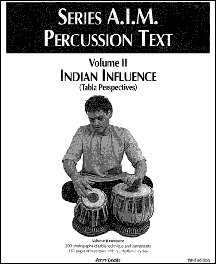 |
This expanded third edition to Volume II reflects a complete rewrite of a tabla book first conceived of in 1985.
Indian Influence presents many carefully examined insights, concepts and philosophies into the critical aspects
for playing north Indian tabla. This tabla text includes thorough explanations of tabla technique, concepts of
rhythmic cycles and playing speeds, plus over 150 pages of performing repertoire within six popular rhythmic cycles.
Over 200 photographs supplement detailed discussions on tabla technique, tabla history and traditional &
contemporary applications, which will illuminate students on how to play tabla. Designed as a detailed teaching
tool, the material in this tabla book unfolds in parallel motion with the evolution of the students' technique
and theoretical understanding of tabla performance. |
Note From the Author
Features
Rhythmic Cycles (Tal, Tala, Taal) |
Compositional Forms |
Reviews
"Jerry Leake has organized and demonstrated the classical form of playing North Indian Tabla and the language that accompanies the lessons in a completely thorough manner. I myself would have trouble learning from a book, but his knowledge of West African and western music help him convey the important points to keep in mind. My students who study this material privately with Jerry go on to incorporate the materials in an extremely musical and personal or individual fashion. To me that alone says a lot about a teacher."Jamey Haddad
Percussionist, teacher
"Jerry Leake has written the best book on tabla I have ever seen. I recommend it to all of my students."
Swapan Chaudhuri
Director of Percussion at the Ali Akbar College of Music in San Rafael, CA and in Basil, Switzerland.
Faculty member at the California of the Arts in Los Angeles.
"AIM Series Two offers the student deep and supportive guidance through the journey of learning tabla and North Indian rhythm. The new edition packs in a significant wealth of material, from repertoire through to theoretical sections. Jerry's personal anecdotes give the reader a feeling that the author not only knows but also loves this material with a passion."
Jonathan Dimond
Instrumentalist, teacher, composer, arranger
Excerpts
This expanded third edition to Volume II reflects a complete rewrite
of a tabla book first conceived of in 1985. Indian Influence presents
many carefully examined insights, concepts and philosophies into the critical
aspects for playing north Indian tabla. This tabla text includes thorough explanations
of tabla technique, concepts of rhythmic cycles and playing speeds, plus
over 150 pages of performing repertoire within 6 popular rhythmic cycles.
Over 200 photographs supplement detailed discussions on tabla technique,
tabla history and traditional
& contemporary applications, which will illuminate students on how to play tabla. Designed as a detailed
teaching tool, the material in this tabla book unfolds in parallel motion
with the evolution of the students' technique and theoretical understanding
of tabla performance. Chapters within this text include: fundamentals
for tabla performance, tabla bols (syllables), tala and laya (rhythm and
tempo), 150 pages of repertoire and detailed appendices which answer most
basic questions about tabla performance. Unique book design presents rhythmic
analysis, reminders & lesson formats in the margin. Tabla Perspectives
contains a thorough set of tabla
terminology, useful compositional
forms and in depth details on rhythmic
cycles to help students in learning tabla. Our resources section provides further information of Indian Music and the tabla drum.
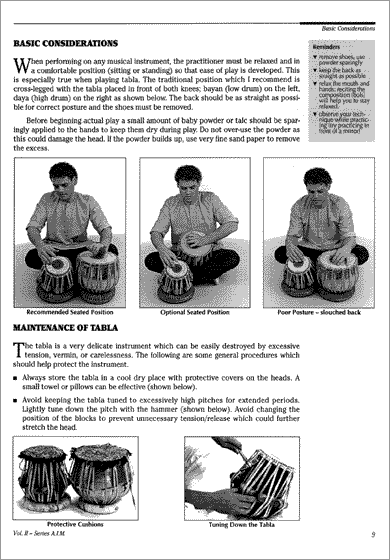
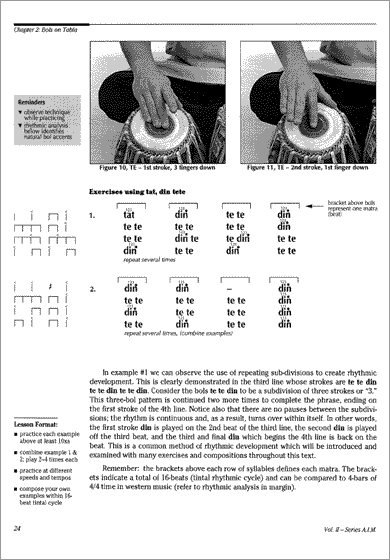
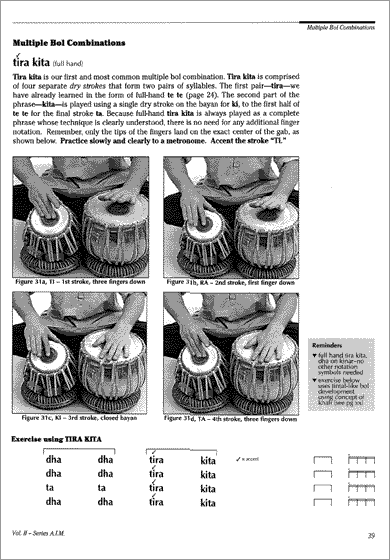
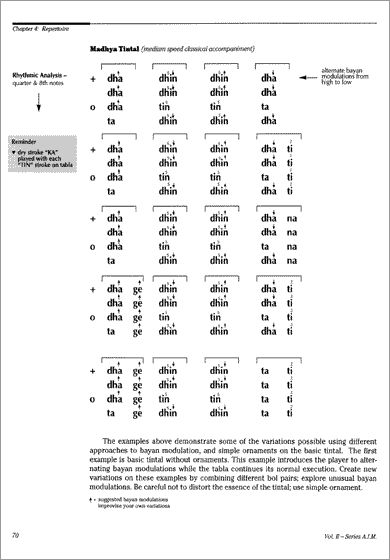

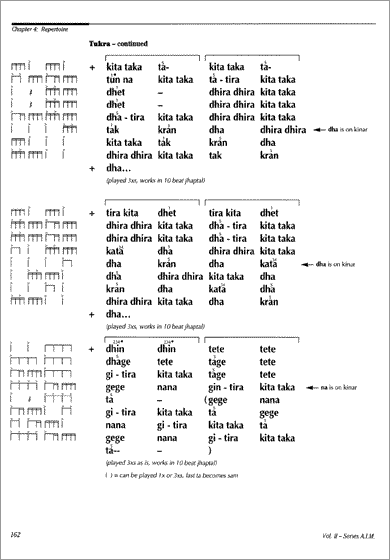
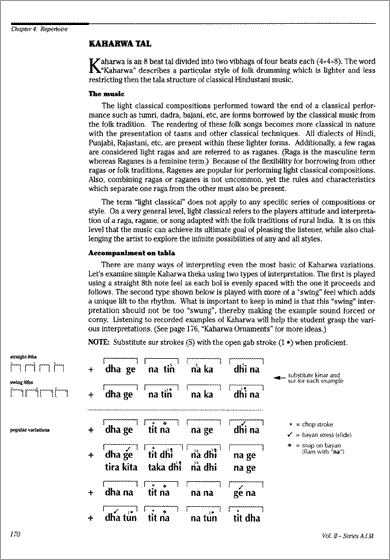
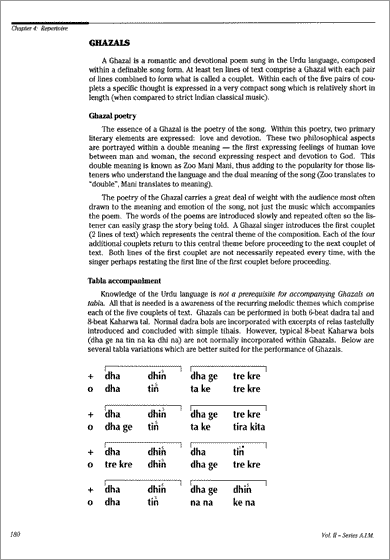
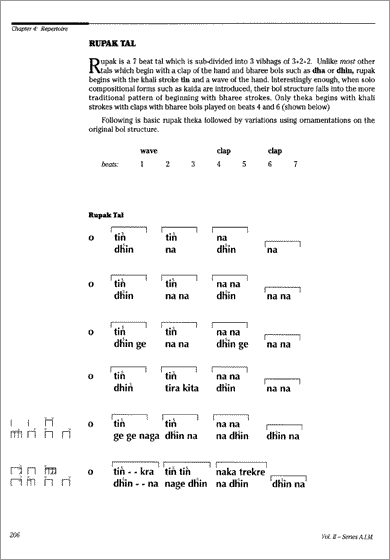
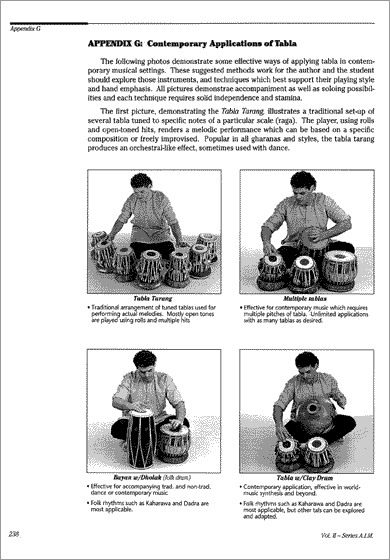
TABLA TERMINOLOGY (alphabetical)
Avartana: One rhythmic cycle. One avartana in Tintal is 16 beats, one avartana in Ektal is 12 beats.Bayan (Duggi): The left hand low drum of the tabla set which produces the bass tones. The bayan is made from brass, German silver, or clay. Bayan literally means "left" (left drum).
Bharee: That portion of the cycle which is emphasized by the open tones of the bayan. Bharee, also spelled as Bhari, literally means "full."
Bol: Means literally "word" and refers to the syllables which are an onomatopoetic representation of the sounds produced on the tabla.
Gab (See-i-e): The black circle which is the location for all closed tones as well as the open "ringing" of tabla. The gab is made from rice powder and iron or magnesium filings, formed into a paste and rubbed onto the skin using a smoothed stone.
Gatte: Wooden blocks used to tune the tabla. The lower the pegs, the higher the pitch.
Gudi: Cushions for the tabla to rest on.
Hathori: Metal tuning hammer.
Khali: That portion of this rhythm cycle which is not emphasized by open tones on bayan. Khali literally means "empty" and is indicated by a wave of the hand in an outward motion. Khali is represented in transcribed material using a zero - "o".
Kinar (Chanti): The outer portion of the tabla head which is very metallic in character. The kinar stroke is the most commonly used stroke on tabla which, with the bayan, is used to begin many rhythmic cycles (dha).
Matra: Means literally "stroke", or beat. Each beat of a rhythmic cycle is called a matra.
Palta: Variations on a given tabla composition such a kaida, rela, peshkar, etc.
Sam (pronounced Sum): Beat one of a given rhythmic cycle which is emphasized by a clap of the hand. This is where the rhythmic cycle both begins and ends and is always notated in transcription using a plus sign +.
Shruti: The Indian melodic scale system.
Sur (Laow): The harmonic tone which results when the tabla is struck directly between the kinar and the gab.
Tabla (Dayan): Although the pair of drums is called tabla, the actual term "tabla" is applied to the right hand high drum. The tabla is most commonly made from shesham wood, Tun or Rosewood. Dayan literally means "right" (right drum).
Tala: The rhythmic portion of North Indian classical music performed on any percussion instrument such as tabla, pakhawaj, naqqara.
Vibhag: Each tal comprises several vibhags, or grouping of bols, for defining the division of phrases. Tintal comprises 4 vibhags of four beats each for a total of 16 beats. 10-beat Jhaptal also comprises 4 vibhags, but their bol groups are 2 + 3 + 2 + 3 (see bottom of next page for further analysis).
TABLA COMPOSITIONAL FORMS (in order of text presentation)
Theka: A fixed set of tabla bols for a tal which cannot be changed and have been passed down through tradition. Theka serves as the rhythmic foundation for the performers to develop improvisations, introduced in slow speed, progressing to medium, then fast.Tihai (pronounced Teehi): A rhythmic phrase repeated 3 times with the final stroke of the third phrase landing on an important beat of the cycle. A tihai is commonly used for concluding a melodic or rhythmic composition. Ti = 3, Hai represents the suffix meaning triple. Bedam Tihai: No rest between phrases (Be = not. Dam = pause).
Mukhra: Short, quickly played tihai which occur during the last beats of a given rhythmic cycle. Mukhra are generally used for adding rhythmic excitement to the conclusion of the rhythmic cycle and tabla composition.
Peshkar: A loosely structured compositional form which introduces the tabla player using more ornamentation and variation of the original theka. Peshkar often introduce fragments of kaida themes before evolving into full kaida presentation.
Kaida: An extended tabla composition which introduces a main theme and proceeds to develop variations while also continuing to restate the main theme (rhythm and variation).
Rela: A short tabla composition comprised of basic strokes which, when played quickly, becomes very exciting and climactic. Relas can develop variations like kaida themes, but this is not a prerequisite for performance.
Gat: A fixed tabla composition of at least one cycle with no specific rules for development. A gat may or may not include bharee/khali sections (such as kaida/rela), it may develop variations, change speeds, and may evolve into other forms such as relas, etc.
Tukra: Means literally "Piece" and can vary in length and structure. Generally, tukras appear similar to Paran in that they can be short compositions which conclude with tihais, but this is not a strict characteristic of a tukra.
Paran: Originating on pakhawaj, a paran is a vigorously played composition which begins on sam, concludes with a tihai and is not subject to additional variation. Pakhawaj parans have been adapted successfully to tabla, but the reverse is not true.
Chakradhar (Tihai): A tabla composition which ends with a tihai with the entire composition played a total of three times to reach sam (beat one) of the next cycle. A chakradhar is a tihai which is placed within another tihai and can exceed lengths of 60 or more matras (beats) to return to sam.
Laggi (pronounced Luggi): A short tabla phrase played repeatedly to a particular rhythm. Usually played in double speed (in relation to the tal), Laggi often displace rhythm to other parts of the beat, creating variations which imply differing accents and stresses.
Lehara: Short repeating melodic composition played within the given rhythmic cycle. Lehara allows the tabla player to demonstrate playing skills within a solo context.
TABLA RHYTHMIC CYCLES
Tintal: 16 beat cycle subdivided into 4 vibhags of 4 beats each
(4 + 4 + 4 + 4 = 16);
Ektal: 12 beat cycle subdivided into 6 vibhags of 2 beats each
(2 + 2 + 2 + 2 + 2 +2 = 12);
Jhaptal: 10 beat rhythmic cycle subdivided into 4 vibhags
(2 + 3 + 2 + 3 = 10);
Kaharawa: 8 beat cycle subdivided into 2 groups of 4 vibhags each
(4 + 4 = 8);
Rupak Tal: 7 beat rhythmic cycle which is subdivided into 3 vibhags
(3 + 2 + 2 = 7);
Dadra Tal: 6 beat cycle which is subdivided into 2 vibhags of 3 beats each
(3 + 3 = 6).
APPENDIX B: Lehara and the Raga System
Lehara
At an early stage in the development of the tabla student, it is important that an understanding of melodic aspects of Indian music be assimilated along with rhythmic. An ideal learning situation would be one which incorporates melodic accompaniment during each tabla lesson, presenting a clearer understanding of how rhythmic compositions relate to melody. This combination of elements, when properly rendered, becomes the basis of Indian music. Indeed, being just a tabla player does not qualify the student for a north Indian classical performance. Only through a heightened understanding of the raga system could the student evolve aesthetically through the music tradition, thus becoming a more capable performer within many diverse north Indian classical music settings.I could not possibly begin to examine the beauty of the raga system without years of research supported by hundreds of pages of compositions. What I introduce at this time are several unchanging melodic compositions, called lehara, which are applicable in all rhythmic cycles. There are ways to interpret and develop these basic compositions using micro-tones, and melodic tihais. However, at this time we are concerned only with learning the skeletal melody for obtaining a better understanding of rhythmic and melodic relationships.
Lehara is usually played on sarangi, violin or harmonium. A lehara is a melody that lasts one cycle of the tala. It is played over and over again without variation as an accompaniment for percussion solos. Lehara tones are usually rather simple, and tend to outline the tala structure clearly, coming to sum in an emphatic and unambiguous manner. Consequently, the tabla player is given a great deal of freedom for developing a solo within the rhythmic cycle. Although lehara is in a traditional raga, the performance does not follow the "time of day" rules. Lehara is a structured composition which, because of its relatively short duration and reiteration, can lack deeper self-revealing expression of a raga. Lehara is an excellent means for the student to understand melodic and rhythmic relationships and does not require a great deal of skill to perform. All that is necessary for playing lehara is the ability to keep steady and consistent time. If you can’t find a sarangi player, record a lehara on any available instrument, from Casiotone to electric guitar. Interestingly enough, lehara machines are now made in India. Also, a recording of the tamboura (drone) would be a helpful addition to one’s practice routine.
An important consideration when playing lehara is determining which key center would be the basis for both melody and rhythm. Common keys for lehara are D, C, C#, and B, with the tabla tuned to the tonic of each key. Note: All of the examples which follow, with the exception of two tintal lehara presented on the next page, are in the key of C and must be transposed to any other necessary key center.
Indian Melodic System
The melodic system of classical north Indian music is quite unique in that is not limited by a tempered 12-note chromatic octave which predominates western music. Indian music utilizes the same 12 note chromatic octave with one critical difference. The 12 notes of the chromatic octave are not tempered to represent specific notes, thereby limiting the Indian musician to just those 12 notes. Within the range of this 12 note octave, the Indian musician incorporates micro-tones which span the entire range of the chromatic octave. This melodic system of micro-tones is called shruti, and is the subject of much debate and controversy.The debate over the shruti system lies in the many attempts to create a scale which defines each micro-tone as smaller notes of the octave. For example, some scholars may consider there to be 4 micro-tones or quarter-tones which separate each chromatic note; thereby creating a tempered system of 44 notes to the octave or 4 x 11 = 44. This is clearly not the basis of the shruti system, as a careful listening to any classical performance would reveal. Indeed, to melodically incorporate quarter-tones with any degree of accuracy and consistency is both a ridiculous and unnecessary proposition.
The laws that govern Indian classical music do not limit the player to any specific melodic interval system. Indeed, the true personality of the player is more uniquely revealed by how he/she utilizes the science of micro-tones within the scale of the raga. It is amazing to hear the subtleties and nuances which a skilled melodicist renders using micro-tones.
Very few western instruments allow the player to create micro-tones on the actual instrument. The trombone is one wind instrument which possess this characteristic. This is clearly demonstrated as the player slides from its lowest note to its highest; achieving an endless supply of micro-tones from low to high. A piano, on the other hand, is designed with specific keys that produce one note of the tempered octave. Also, the entire string family of instruments from violin to contra bass requires the player to press the string against the fingerboard in very specific yet unmarked locations. To do this correctly, players of string instruments must possess finely attuned ears and precise technique for locating the note on the instrument and hearing it properly when played. Interestingly enough, many of today's contemporary players strive for ways to produce micro-tones on tempered musical instruments, including piano.
The solfege system of western music (Do, Re, Mi, Fa, So, La, Ti, Do) is also practiced in an Indian classical form. The syllables assigned to notes of t he Indian scale system are Sa, Ri, Ga, Ma, Pa, Da, Ni, Sa. This system is called Sargam and is the north Indian equivalent of the solfege system. Within the specific scale of the raga, which may include some or all of the notes of the Sargam system, the player improvises many subtleties using micro-tones and nuances which the raga prescribes and allows.
A raga is much more than just a scale with specific notes that are often treated differently within ascending and/or descending phrases. A raga is also much more than just a mood or emotion which dictates the specific time of day it is to be played. A raga is a combination of many simple and complex elements which support hundreds of hours of intensive practice and performance experience.
Using the prescribed scale of the raga, the player builds his/her improvisations by introducing micro-tonal and rhythmic ornaments along the way. However, much more important than the ability to improvise within a scale, the player must learn and experience many unique melodic characteristics which embody the essence of any given raga. This could entail the study of specific melodic phrases and nuances of the raga, learning the reoccurring melody called gat and the mukhra which anticipates sum, or aesthetically rendering any number of melodic treatments and techniques which the player evolves.
During alap, the solo melodicist brings the raga to life by introducing each note of the scale very gradually and patiently. In further presenting the alap, the performer utilizes various nuances to hint at and sometimes tease the important notes and phrases of the raga, heightening the enjoyment of the music. The listener might assume that the melody is loosely improvised by the player when, in fact, the raga is gently introduced then slowly developed through the mood of the raga and the personality of the player.
A curious aspect of a raga is the time of day which it is to be performed. Why is it that a morning raga is played only in the morning while an evening raga is played in the evening? Why is it, then, that some people are morning people who can seize the start of the day upon waking up, while others need their three cups of coffee and 20 minute shower? Conversely, why are some people at their peak in the evening, seizing more inspiration at the end of a given day? The unique qualities of each individual are also present in the composition and performance of any raga. Certain scales and melodic treatments that comprise a raga may be more attuned to a morning performance. A morning raga may be more relaxed, whereas an evening raga may produce a more lively and energetic performance, better suited for later hours.
When the tala portion of the music begins, the tabla player also has a specific structure of notes (bols) and phrases; some more important then others. During this portion of the concert, both melodic and rhythmic instrumentalists perform a sort of musical game, emphasizing and de-emphasizing specific notes of the scale and bols of the rhythm cycle-together and yet independent from the other. Unlike the raga itself, which is performed at specific times of day, the compositions and improvisations played on tabla have no prescribed time of day for performance. Indeed, a morning, afternoon and evening raga could each be performed in any tal or speed.
As an untrained member of the listening audience, you may experience many shifts of mood and even changing degrees of acceptance for the music. This is not entirely uncommon and may be partially attributable to certain basic western music elements which are either absent or disguised within Indian music. An astute yet new listener to Indian music may notice an absence of harmony which their western ears have become accustomed to. Nor would there appear to be any counterpoint using multiple melodic lines which intertwine in obvious fashion. The sincere listener who hears Indian music with an open mind will ignore the absence of harmony and counterpoint and simply witness a richly packed concert often performed by as few as two players. Indeed, a single melodicist who leads the performance and a single percussionist who drives it are often all that is necessary to astound the experienced and new listener.
A raga is both simple and complex. It is, however, infinitely easier to understand than to perform. As a science and performance art form, a raga is as deep as the largest ocean; an ocean which yields a bounty of musical resources. A raga is, in essence, like life itself, with each performance like a uniquely new day.
APPENDIX C: The Many Roles of the Tabla Player
The tabla, as we know, is a rhythmic instrument whose primary function is to provide interesting and complementary accompaniment for the melodicist and, ultimately, the listener. Indeed, all instrumentalists in a classical North Indian concert work together to present an integrated performance which can encompass many diverse roles for each player. Within any given performance, melody and rhythm intertwine in a very smooth sounding yet highly sophisticated web of support and feature; feature and support. The ease at which an accompanying role on tabla can transition to a featured soloing role is often indistinguishable as rhythms flow from the drums with grace and vigor. A qualified tabla player must possess a great deal of trained and natural musical instinct for maintaining these diverse roles throughout the music event.Players from today’s school of tabla focus more on accompaniment for providing the rhythmic texture which drives the music toward its eventual peak. The old school of tabla performance illustrates players of incredible solo virtuosity and majesty who would, undoubtedly, be featured throughout a given performance. This power and drive still exists with the tabla players of today, only much more emphasis is placed on the role of accompaniment, as opposed to the role of soloist. Tabla solos appear in the form of shorter time spans which are intertwined within the accompanying rhythmic cycle. Today, a much more "back-and-forth" format is practiced as melodicist and rhythmicist trade solo opportunities with mutual generosity and respect for each other.
Much of today’s attitude towards accompaniment illustrates a great deal of improvisation within the rhythmic cycle. Indeed, the ability to play interesting and developing theka throughout a given performance can be considered just as important a skill as the ability to play powerful solos. In fact, many of today’s melodicists prefer a tabla player who puts sophisticated accompaniment ahead of repertoire and technique. This does not limit the tabla player. On the contrary, it expands the true meaning of the word "improvisation." Memorizing and recalling complex tabla compositions and rendering them at the appropriate time can be a puzzling and awkward moment. A clear understanding of theka and its many rhythmic variations, however, can make the music flow quite nat urally and spontaneously from the soul of the musician. This relaxed method of play is fueled by the player’s natural musical talent and their ability to capture the spontaneity of the music event. Overall, this "sharing" approach towards Indian music produces a much more gratifying experience for both players and listeners alike.
The more experience a tabla player has, the more astute their awareness becomes about how their roles change within different instrumental situations. A skilled tabla player has learned that their approach towards accompanying a vocalist would differ from their approach towards accompanying a sitarist or bansuri player. In other words, the tabla player does not interpret the music and rhythmic cycle the same way for different melodist. This would be like asking a jazz drum set player to apply jazz rhythms to funk music; the two styles of music require different disciplines. Indeed, discipline is the primary characteristic of a skilled tabla player (as it is of any good musician).
Each melodicist presents their own unique style and approach toward the rendering of any raga on any traditional instrument. Quite wonderfully, each player interprets a raga with their own unique personality that is expressed through their chosen instrument. This complex combination of expression would, undoubtedly, produce completely different qualities of interpretation and mood. The melodist could perform the same raga with a variety of different moods and expressions that could create the effect of a completely new musical performance for those who are less educated on the science of the raga system.
As the tabla player performs, their love and appreciation for the music is what is truly expressed; not a complex web of intellect that could generate a cold and stiff rendering of the rhythms. A great deal can be said about what one should keep in mind as one plays. Unfortunately, words could never properly convey the aesthetic of a music that offers so much. Active participation in many relaxed yet constructive musical experiences is the only way to completely explore the many attitudes and roles that must occur. And with these attitudes and understanding comes a fluid and graceful tabla performance.
Look, listen and learn. With a basic awareness of just this simple phrase much more can be uncovered about the incredible depth and beauty of classical Indian music.
To help illustrate how the tabla player performs within differing roles, lets look at a sample performance from beginning to end. This example is presented as a very general summary of what a classical Indian music concert might entail. Do not interpret this as an end all for all performances as each performance is uniquely different from the next.
Alap
The melodic soloist performs a serene opening of the raga. Through various subtleties, the melody of the raga gradually unfolds without any specific rhythmic undercurrent. The overall mood of the alap is expressed through the personality of the soloist who develops each note of the raga very slowly through improvisations of short and long phrases while hinting at the predominant notes and phrases of the raga.
Jor
While still performing the solo alap, the melodicist increases in tempo s lightly while developing the raga through further improvisations. More emphasis is placed on rhythmic phrases without introducing any specific rhythmic pulse. In Dhrupad music, Jor is called dugan (double) alap.
Jhala
Still performing alap, the soloist plays faster and more rhythmic phrases which encompass the entire range of the instrument being played. This is a very fast and exciting ending of the solo alap which first started with very long and relaxed melodic passages. Jhala is a melodic technique which incorporates reiterated notes accompanied by fast plucking or blowing of drone pitches. At the conclusion of the alap, jor and jhala, the soloist has expressed much of what the raga means and feels. In Dhrupad music, jhala is called chaugun (quadruple) alap.
Tala or Tal
Tala is the base of time and rhythm which is formally established by the entrance of any rhythmic instrument such as the tabla. Tala is the framework for rhythmic development upon which the instrumentalists build their compositions and improvisations. The tala can remain at a given fixed laya (speed), or it can change speed for further development.
Tabla entrance in vilambit tintal:
- beginning first with simple and relaxed accompanying theka variations, the tabla player introduces basic ornaments and mukhra which compliment the unfolding raga
- theka presentation continues with periodic introduction of peshkar which return to theka upon completion
- introduction of short compositional forms such as peshkar between accompanying rhythmic cycles
- tempo increase or doubles to madhya laya, as determined by the melodicist
Tabla continues in madhya laya (medium speed)
- tabla accompaniment becomes more interactive as ornaments and tihai/mukhra further compliment the development of the raga
- solo patterns on tabla become longer through the presentation of kaida, rela, etc.
- tabla continues interactive accompaniment, anticipating opportunities for short tabla solos. Again, the melodist controls the direction of the performance, eventually entering drut laya (fast speed).
Tabla continues in drut laya
- tempo increases into drut laya as the melodist plays very fast melodic runs called taans.
- the tabla accompanies using fast theka variations played with occasional tihai and mukhra which complement the melodist. Fewer emphasis is placed on tabla features; more emphasis is placed on clear and precise accompaniment
- as the tempo reaches its peak, the instrumentalist play harder and faster with explosive dynamic intensity. During this emotion packed conclusion, the tabla must maintain clear drut theka with only occasional mukhra or tihai incorporated
- melodist performs concluding melodic chakradhar tihai which the tabla player recognizes and further complements. This chakradhar can be played in unison for the entire chakradhar or for the concluding portion of it.
- raga ends on beat one (sam) of the next rhythmic cycle (tabla player stops playing)
- melodicist embellishes small gentle phrases and/or textures which relax the mood and ease the intensity of the concluding chakradhar
APPENDIX E: Melodic Instruments of Indian Classical Music
The instrument descriptions and photographs which follow were generously provided by my colleague Warren Senders, who is himself a highly accomplished vocalist and scholar of North Indian Classical music.Drone Instruments
Tamboura. The Tamboura provides the continuous drone against which melodies may be heard. Generally, the tamboura has either four or five strings, most tuned to the fundamental, or tonic pitch. Other notes included in a tamboura tuning can include the fifth, fourth and seventh of the scales. Different ragas may emphasize different pitches, and this is sometimes reflected in the tuning of the tamboura. The body of the tamboura is made from a large gourd, a member of the pumpkin family. I’m told that the gourds are grown inside clay pots, to ensure that they take on the correct shape. The most characteristic quality of the tamboura is its constant buzzing sound, produced by a specially designed bridge about an inch across with a very shallow slope. As the strings are plucked, they ‘buzz’ against the bridge, which increases the sustaining quality of their pitches. Further adjustment is accomplished by moving a small thread back and forth between the string and bridge. The buzzing (and the bridge adjustments controlling it) is called jawari (‘life’). A well-adjusted jawari obscures the attack of each string, making a rolling, droning carpet of sound.Harmonium. Resembling a small piano with bellows for producing its sound, the harmonium is capable of playing both a drone and melody. As a drone, the player chooses the necessary notes of the raga and selects them on the harmonium which is played by the melodicists or desciple. As a melodic instrument, the harmonium is most often used to shadow the improvisations of the vocalists, providing additional textures and "resting time" for the singer.
Plucked Stringed Instruments
Been. The generic term for musical instrument in ancient Indian texts is veena, but the term nowadays refers usually to stringed instruments. While the veena is commonly used in South Indian music, its closest equivalent in Hindustani tradition is known as rudra veena, or, alternatively, been. The instrument has a cylindrical body with two large gourd resonators mounted on either end. Its tone is deep, resonant and profound — not an instrument to be played frivolously! (not pictured).Surbahar. Essentially a bass sitar, the surbahar draws a variety of playing techniques from both the sitar and the been. The surbahar and sitar use resonating strings, and that sonority has become intrinsic to their style — especially apparent during alap.
Sitar. The sitar is probably the best known instrument in North Indian music. It is a long necked lute with sympathetic strings which resontate during performance.
Sarod. The sarod is derived from the ancient Persian rabab which came to India through Kashmir. Its polished metal fingerboard is ideally suited to Hindustani music’s long slides and oscillations.
Vichitra Veena. The Vichitra Veena is India’s version of the lap-steel guitar. On this extremely rare instrument, the notes are stopped with an egg-shaped piece of glass held in the left hand, creating an extremely distinctive sound. It rests on the floor in front of the player. Lalmani Misra was one of the only recognized virtuosi on this instrument.
Slide Guitar. Brij Bhushan Kabra has achieved a truly remarkable adaptation of the western slide guitar to the requirements of Hindustani music. Adding drone strings, changing the action and rearranging the playing strings to suit the needs of lap-style playing, Kabra has essentially created a new instrument sharing only basic body structure with the Western guitar.
Bowed Stringed Instruments
Sarangi. The Sarangi is a bowed instrument, but one with so many special features it fits in a class by itself. At first a folk instrument, it became over the past two-hundred and fifty years the primary melodic accompaniment for vocal music (although it’s now often replaced by the harmonium). It has between forty and fifty sympathetic strings, which give the instrument its shimmering, resonant tone quality. The technique calls for the player’s fingers to touch the strings lightly on the side — not pressing down on the fingerboard. This is fiendishly difficult, but allows very subtle melodic control.Violin. The British introduced the violin to India, and it became very popular in Carnatic music. The use of violin by Hindustani musicians is a somewhat later development, only a little older than this century. While the instrument is virtually unchanged, the playing technique uses an extensive repertoire of slides, smears and finger motions that are not partof a Western player’s standard vocabulary. It is held between the player’s chest and heel; thus braced, the fingering hand has enormous freedom of motion.
Wind Instruments
Shehnai. The shehnai is Hindustani music’s version of the oboe — a small double-reed instrument with six holes. Bismillah Khan is single-handedly responsible for introducing the shehnai to the concert platform; before he made it "respectable" it was considered good only for outdoor occasions, like weddings, parades and festivities. He is now in his seventies and still performing frequently.Bansuri. The Bansuri (bamboo flute) is an ancient instrument, but its introduction to Hindustani classical music is relatively recent. The flute is often depicted in the hands of Krishna, who used it as an instrument of seduction. Flute music conveys a strong romantic quality to Indian minds.
Melodic Percussion
Jal Tarang. The Jal Tarang is a rare instrument; it’s used more as a source of incidental music for films than as a vehicle for soloists. Made from a set of 15 graduated china bowls filled with water, it’s played with a set of tiny mallets. The word "Jal" means "water;" "Tarang" means "wave."Santoor. The Santoor is India’s version of the hammered dulcimer. Originally from Kashmir, it has been brought to the concert stage by Pandit Shivkumar Sharma, who has developed many new techniques that bring new levels of expression to the instrument. A trapezoidal box with over a hundred strings stretched across in multiple courses, it’s played with a pair of tiny mallets shaped like hockey sticks.
Tabla Tarang. The Tabla Tarang is a set of tuned tabla drums arranged to follow the notes of a selected raga scale. The player uses delicate hand motions to create an effect somewhat similar to the jaltarang (see page 238 for photo and further description.)
INDEX
Aada tal, 74, 221Ajrada Gharana Exponents
(sequenced chronologically)
Kallu Khan, 17
Muhammadi Baksh, 17
Kale Khan, 17
Hassu Khan, 17
Shammu Khan, 17
Habeebuddin Khan, 17
Abdul Karim Khan, 17
Alap, 230
Amir Khusrau, 3, 4, 8
Arabic, 186
Arapan tal , 223
Avartana, 12, 190
Bajan, 183-185, 187, 189
Banaras Gharana Exponents
(sequenced chronologically)
Ram Sahay, 17
Janaki Sahay, 17
Ramsharan, 17
Bharon Sahay, 17
Bhagatjee, 17
Pratap Maharaj, 17
Janaki Sahay, 17
Gokul, 17
Vishwanath, 17
Durgajee, 17
Bikkujee, 17
Gama Maharaj, 17
Gummojee, 17
Rangnath Mishra, 17
Bhairon Sahay, 17
Baldeo Sahay, 17
Nunhujee, 17
Bhola Shreshtha, 17
Kanthe Maharaj, 17
Kishan Maharaj, 17
Pandit Bhairav Prasad, 17
Maulaviram Misra, 17
Mahabir Bhat, 17
Pandit Mahadeo Mishra, 17
Pandit Anokhelal, 17
Nageshwar Prasad, 17
Ramji, 17
Mahapurush Mishra, 17
Pratap Maharaj, 17
Jagannath, 17
Shivsunder, 17
Bacha Mishra Shivsunder, 17
Banmohan Maharaj, 17
Gudai Maharaj, 17
Samta Prasad, 17
Pandit Sharada Sahay, 17
Pandit Kishan Maharaj, 17
Banaras, 14, 17, 18, 23, 35, Banaras Kaida, 109-113, 121, 127, 138
Bansuri, 229, 236
Been, 235
Bul-bul, 187
Calcutta, 16
Chachar tal, 221
Chakradhar, 13, 25, 36, 43, 119, (kaida); 165-169, (tintal); 193 (ektal); 205, (jhaptal); 214, 231, 232
Chautal, 190, 223
Chilla, 7
Clay Drum, 238
Congas, 239
Cymbal, 239
Dadra, 13, 59-60, 214-218
(performance); 233, 237, 238
Damaru, 4
Deep Chandi, 59-60, 222
Delhi Gharana Exponents
(sequenced chronologically)
Sudhar Khan Dhadhi, 15, 16
Mian and Modhu Bakshu, 15
'Haji' Vilayet, 15
Ram Sayah, 15
Kallu, 15
Miru, 15
Shitab Khan, 15
Bugara Khan, 15
Ghasita Khan, 15
Modhu Bakshu, 15
Mian Bakshu, 15
Ghasita Khan, 15
Nasir Ali, 15
Bade Kale Khan, 15
Gulab Khan, 15
Chhote Kale Khan, 15
Gahem Khan, 15
Inam Ali, 15
Chand Khan, 15
Lilli Masit Khan, 15
Langde Hussain Baksh Khan, 15
Nanhe Khan, 15
Sudhar Khan Dhadhi, 15
Roshan Khan, 15
Kallu Khan, 15
Tullan Khan, 15
Shitab Khan, 15
Bolibaksh Khan, 15
Munir Khan, 15
Amir Hussain Khan, 15
Ahmedjan Thirakwan, 15
Nasir Khan Panipatwale, 15
Shamshuddin Khan, 15
Natthu Khan, 15
Habeebuddin Khan, 15
Jugna Khan, 15
Mehboob Khan Mirajkar, 15
Abdul Mirajkar, 15
Mehboob Khan Mirajkar, 15
Pandurang Salunke, 15
Jaiwantrao Mirajkar, 15
Delhi/Delhi Style, 3, 4, 14-16, 35, 41, 52-54, 104, Delhi Kaida; 108-110, 114, 116-120, 122-126, 128, 132-133, 139, 202, 209, 210, Delhi Rela; 145, 191
Devasthali, Pandit Shreeram, 6
Devasthali, Rajiv, 15
Dhamar tal, 223
Dholak, 186-188, 238
Dhrupad, 190, 230
Dimdi, 188
Drum Set, 240
Drut Laya, 61, 65, 76-77 (tintal); 190, 193, 196, (ektal); 199 (jhaptal); 221-222, 231
Duff, 188
Ektal, 12-13, 59-60, 66, 190-197 (performance); 226 (lehara), 237
Ektari, 183
Farukhabad Gharana Exponents
(sequenced chronologically)
Bakshu Khan Dadhi, 16
Vilayat Ali Khan Dadhi, 16
'Haji' Vilayat Ali, 16
Hussain Ali Khan, 16
Nanhe Khan, 16
Masit Khan, 16
Karamatullah Khan, 16
Sabir Khan, 16
Masit Khan, 16
Azim Khan, 16
Munne Khan, 16
Gyanprakash Ghosh, 16
Haji Vilayat Ali Khan, 16
Salari Khan, 16
Chudia Imam Baksh, 16
Haider Khan, 16
Bande Hussain Khan, 16
Mubarak Ali Khan, 16
Chunnu Khan, 16
Hussain Ali Khan, 16
Nissar Ali Khan, 16
Munir Khan, 16
Amir Hussain, 16
Fakir Hussain, 16
Gulam Hussain Khan, 16
Ahmadjan Thirakwa, 16
Babeebudding Khan, 16
Nasir Khan, 16
Abdul Karim Khan, 16
Shamshuddin Khan, 16
Farukhabad, 14-16, Farukhabad Kaida, 130, 137
Frame Drums, 239
Gaja Jhampa tal, 223
Garba, 188
Gat, 13, 74, 154-158 (tintal); 193, 197 (ektal); 198, 200 (jhaptal); 213 (rupak tal); 222, 228
Gharana, 14-18, 21, 30, 32, 40, 42, 52, 88, 165, 182, 189, 198, 237, 238
Ghazal, 180-182, 189
Guru-Shishya, 7
Halghi, 188
Harmonium, 225, 235, 236
Hindi, 170, 183, 186, 237
Indore, 16
Jagapala tal, 224
Jal Tarang, 236
Jhala, 230
Jhaptal, 12-13, 59-60, 65, 66, 83. 198-205 (performance); 226 (lehara), 237
Jhumra tala, 223
Jor, 230
Kachhi Dhol, 188
Kaharwa, 13, 28, 45, 61, 170-179 (performance); 180, 182, 183, 185, 187, 221, 237
Kaida, 7, 12-14, 16-18, 29, 78, 81, 88, 97, 231, 233, 234, 237, 240,
Tintal, 106-141
Ektal, 193, 196
Jhaptal, 198, 202-205
Rupak, 206, 209-212
Dadra, 214
Kathak, 16, 159
Khyal, 3, 190
Kinar, 12, 16, 26, 32, 71, 96, 102, 159, 161-164, 187, 190, 224, 232-233, 240
Laggi, 173-176, 181-183, 221-222, 234, 240
Lehara, 225
tintal, 225, 226,
ektal, 226,
jhapta, 226
rupak tal, 226
Lucknow, 16-17
Lucknow Gharana Exponents
(sequenced chronologically)
Makkhu Khan, 16
Modu Khan, 16
Bakshu Khan, 16
Sudhar Khan Dhadhi, 16
Mammu Khan, 16
Muhammad Khan, 16
Bade Munne Khan, 16
Abid Hussain, 16
Bade Munne Khan, 16
Wazid Hussain, 16
Afaque Hussain Khan, 16
Ilmas Khan, 16
Abid Hussain Khan Biru, 16
Mishra of Banaras, 16
Jehangir Khan, 16
Hiru Ganguly, 16
Madhya Laya, 61, 70-73, 76, (tintal); 179, (kaharwa); 190-196, (ektal), 221, 231
Matra, 12, 20, 24, 28, 61, 76, 80, 83, 88, 194
Micro-tones, 227
Mukhra, 13, 67, 69, 76, 78, 80-81, 84-87, 92-93, 190, 193-194, 198, 228, 231
Naggara, 12, 239
Non-traditional thekas, 224
Pakhawaj, 4, 12, 13, 16-18, 25, 30, 77, 82, 190
Palta, 12, 109, 126, 137
Paran, 13, 16-18, 36, 43, 159, 163, 165, 190, 203
Persian, 186
Peshkar, 12-13, 16-18, 106, 231
Tintal, 72, 88-105
Purab Peshkar, 104
Tisra Jati, 101-104
Ektal, 195
Jhaptal, 200
Rupak, 208
Punjab, 18, 237
Punjab Gharana Exponents
(sequenced chronologically)
Fakirbaksh Khan, 18
Kadirbaksh Khan, 18
Haddu Khan, 18
Karam Ilahi Khan, 18
Baba Malang, 18
Malan Khan, 18
Firoze Khan, 18
Pandit Baldeo Sahay, 18
Lal Muhammad Khan, 18
Shaukat Hussain Khanv
Alladitta Khan, 18
Allarakha Khan, 18
Zakir Hussain, 18
Taufiq, 18
Fazal Qureshi, 18
Qwali, 186-189
Raga, 3, 190, 192, 193, 225, 227-231, 235-236, 238
Rela, 12-18, 29, 50, 78, 81, 88, 92-93, 154, 165, 169, 181, 231
tintal kaida/rela: 124, 126-127
tintal rela, 142-153
rela/laggi, 173
bajan/rela, 185
ektal, 193
jhaptal, 198, 200
rupak tal, 213
dadra, 218
Riaz, 5, 6, 7, 22
Rupak Tal, 13, 59-60, 66, 206-213 (performance); 226 (lehara), 237
Santoor, 236
Sarangi, 225, 236
Sarod, 235
Shaker, 239
Shehnai, 236
Shruti, 12, 227
Sitar, 235
Sitar Khani, 74-75, (theka); 233
Slide Guitar, 235
Surbahar, 235
Sul tal, 224
Sulphak tal, 224
Sur, 10, 12, 16-17, 32-34, 36-37, 43, 49, 67, 74, 76, 104, 159, 170, 190, 212
Suratwala, Niteenbhai, 188
Taans, 231
Tabla
basic considerations, 9
tuning, 9-11
terminology, 12
compositonal forms, 13
Tabla Bols, 4-5, 9
Technique, 21-56
Bols on Right Hand Daya, 23
Bols on Left Hand Bayan, 25
Open Tone Bols on Bayan, 26
Composing New Variations, 29
Modulating the Bayan, 30
New Bols on Right Hand
Tabla, 32
Dry Strokes from TA Position, 34
Combined Bols on Both Drums, 36-38, 41-45
Multiple Bol Combinations, 39-40, 46-49
Assorted Bol Exercises, 50-51
Assorted Hand and Finger Exercises, 52-53
Summary of Tabla Bols, 54
Bharee/Khali Substitution, 55
Tabla Tarang, 236, 238
Tal Bells, 184
Tal/Tali
Tali Clapping/Keeping Tal, 59
Finger Counting Other Tals, 60
Laya (speed), 61
Five Classes of Tal, 62
Tamboura, 235
Tasha, 188
Thirakwa, Ahmed Jan, 5, 6
Theka, 13, 65-66 (general); 67-73, 76-77, (tintal); 79, 85, 169, 170, 181, (misc.); 190, 192-194 (ektal); 198 (jhaptal); 206 (rupak); 214 (dadra); 221, 223, (assorted); 222 (deep chandi); 229, 231
Tihai, 13, 29, 36, 43, 49, 67, 69, 71, 76, 78-87 (tintal compositions); 106-111, 113, 115, 117, 119, 123, 129, 131, 133, 135, 137, 138, (tintal kaida tihai); 142, 144, 145, 147-149, 151, (tintal rela); 165-169 (tintal chakradhar tihai); 175, 180-181 (kaharwa/ ghazals); 193-195, 197 (ektal); 198, 203, 205 (jhaptal); 207, 209-212 (rupak); 222, 225, 231
Tilvada tal, 223
Tintal, 12, 13, 20, 24, 28, 38, 39, 47, 55, 59, 60, 65-76 (theka); 78-84
(tihai); 85-87 (mukhra); 8-105 (peshkar); 106-141 (kaida); 142-153 (rela);
154-158 (gat); 159-164 (tukra/paran); 165-169 (chakradhar); 221-222, 225-226 (lehara); 231, 233-234, 237
Trippoli, 12, 167-168
Tukra, 13, 36, 159-164, (tintal); 193, 197, (ektal); 201, 205, (jhaptal); 213, (rupak tal); 233
Tun-tuna, 188
Urdu, 180, 186, 237
Uthan, 169
Vibhag, 55, 56, 59, 63, 66, 67, 74, 79, 80, 84, 85, 88, 93, 190, 198, 206, 214, 221, 233, 234
Vichitra Veena, 235
Vilambit Laya, 61-62, 65, 68-69, 82, 85-86, 106, (tintal); 190-194 (ektal); 221-222, 231
Violin, 225, 236
Wood Blocks, 239
